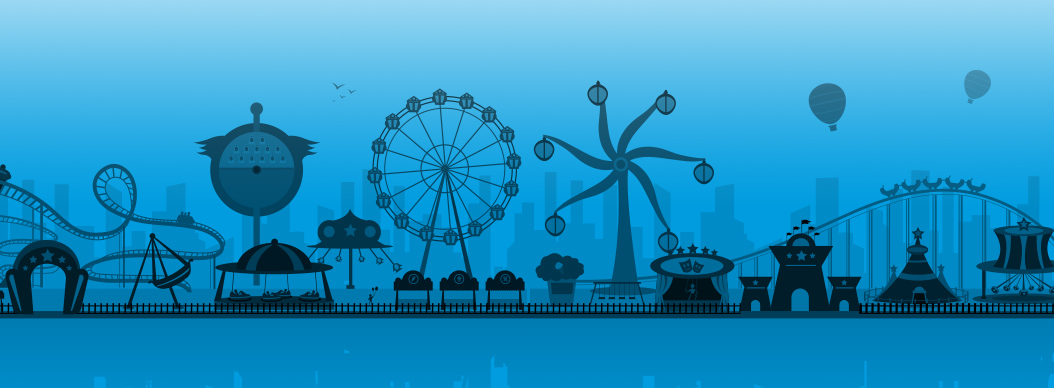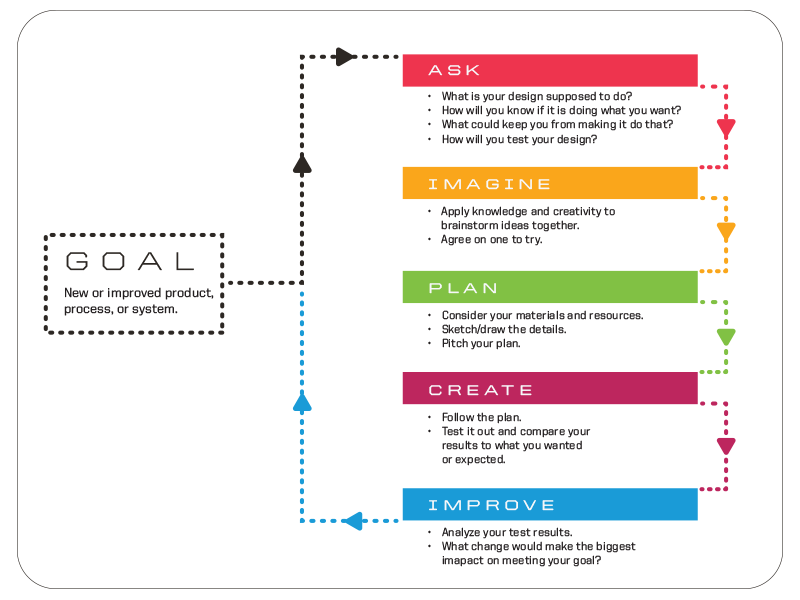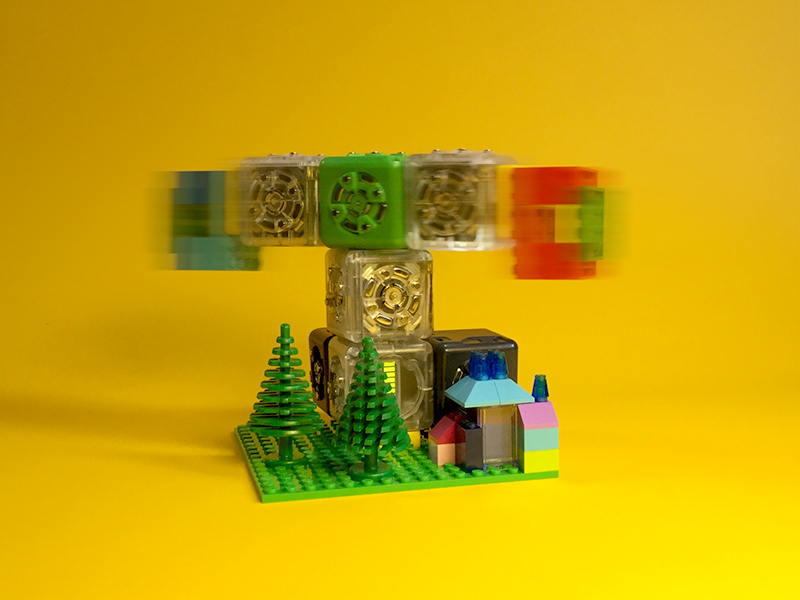A.M.13 | Amusement Park Ride

Created by: Modular Robotics
Lesson Overview:
This is a three-part lesson. One day, students will work in teams to design an Amusement Park Ride Robot. Another day, students will have a chance to create a presentation describing their Amusement Park Robot. On a third day, the teams will present to a panel evaluating the robot. This panel will act as judges for the Amusement Park Company looking to add a new ride that will generate a lot of excitement and bring more people to the park. Each team of students will be presenters hoping to convince the panel to accept their ideas. Every student will also have a chance to be on the board asking questions of the presenters and voting for their favorite idea. A few days in advance of this lesson, give your students a brief idea of what this project is all about so they can be brainstorming some ideas.
The Basics:
Ages: 10 – 12 years (grades 4-6)Time: 45 – 60 minutes
Prep Time: 5 minutes
Lesson Goal (for the educator): To allow teams to work together on presentation skills necessary to convince a panel to accept their invention.
Lesson Objectives (for the students): My team will work together to design and build, and later present, an Amusement Park Ride Robot.
Essential Questions: What should my team consider to be important in the design and construction of our Amusement Ride Robot? What is the necessary information to outline for the panel? What is the best way to deliver this information?
21st Century Skills: Creativity and Innovation, Critical Thinking and Problem Solving, Communication and Collaboration, Adapt to Change, Be Flexible, Manage Projects, Produce Results, Work Effectively in Diverse Teams
Concepts: Collaborating with others, making presentations
Vocabulary: Prototype
Required Cubelets: As many as possible
Additional Materials: Student Robotics Journals, Cubelets Brick Adapters, Lego pieces, other essential materials your teams ask for to complete the project and presentation
The Standards:
ISTE: International Society for Technology Education- Creativity and Innovation 1.a, 1.b, 1.c, 1.d
- Communication and Collaboration 2.a, 2.b, 2.c, 2.d
- Research and Information Fluency 3.a, 3.d
- Critical Thinking, Problem Solving, and Decision Making 4.a, 4.b, 4.c, 4.d
- Digital Citizenship 5.a, 5.b
- Technology Operations and Concepts 6.a, 6.b, 6.c, 6.d
CCSS: Common Core Standards
- ELA-Literacy.W.4.10 ELA-Literacy.SL.4.4 ELA-Literacy.SL.4.5
- ELA-Literacy.W.5.10 ELA-Literacy.SL.5.4 ELA-Literacy.SL.5.5
- ELA-Literacy.W.6.10 ELA-Literacy.SL.6.4 ELA-Literacy.SL.6.5
NSTA: National Science Teachers Association
Prior Knowledge Necessary for the Student:
Prior Knowledge Necessary: An understanding, and practice, of using the Engineering Design Process considering users, criteria, and constraints
- If no prior knowledge: A.M.9 through A.M.12
Prior Knowledge for the Educator:
You may want to think about setting your own criteria and constraints for this project – unless you just want the sky to be the limit!Educator Tips:
You may want to tie this into a study on simple machines.Preparation:
- A few days in advance of this lesson, give your students a brief idea of what this project is all about so they can be brainstorming some ideas.
- Divide the students into teams of 2-5 students to work as a team.
Lesson Plan Assets and Resources:
Click the button to download Appendix A.M.13.WS – Amusement Park Ride
Click the buttons to download the Robot Journal and Extra Journal Pages
Lesson Part I:
Introduction:
“Today is the day we will begin to work in our teams to design and build an Amusement Park Ride Robot. Your team’s packet (A.M.13.WS) will guide you through the process. It will be important for your team to brainstorm ideas, consider the criteria and constraints, and think about the user when designing your Amusement Park Ride Robot.”

-
Time: 3-5 Minutes
- “You will need to use your prior knowledge about the Engineering Design Process to construct your robot with your team. Everyone must work together and later you will each be asked to evaluate yourself, and your teammates, on how well you all collaborated.”
- “After your team designs and builds the prototype, your team will be working together to market your robot in preparation to try to convince the Amusement Park Panel to accept your design for their new ride. We will talk more about this at that time. For today, your team needs to design and build.”
- Review the Objective and introduce/review the vocabulary. Time: 20-30 Minutes
- This is an exploratory project where the kids are involved. Facilitate by helping them find necessary materials and asking questions to expand their thinking. Make sure they are using the design process, working together amicably, and just enjoying the challenge.
Closure/Evaluation
-
Time: 2-3 Minutes
- Allow time for students to put materials away and plug in the Battery cubes for recharging. Time: 5-10 Minutes
- Give students time to record their thoughts about this lesson in their Robotics journal.
End Results:
Students will have an opportunity to collaborate on a project, using the design process. They will have a chance to be creative, collaborate, problem solve, and construct a prototype.Extension Activities:
What did you learn about yourself while working on this project with your teammates? What are some important things to remember when a team is working together on a project such as this one?What To Go To Next:
All students will go on to Part Two of this project.Lesson Part II:
Now that the teams of students have each built a prototype of their Cubelet Amusement Park Ride it is time for them to work on their presentation. On this day, have the teams work together to plan the presentation they will make to the Amusement Park Panel.
Prior Knowledge for the Educator:
This is an opportunity for students to practice presentation skills and for you to cover guidelines such as:
- eye contact
- speaking clearly
- body language
- presenting persuasive arguments
- using notes vs. memorizing
This is a great opportunity to have students use digital images for a slide presentation if you have the necessary equipment. If not, help students come up with other ideas such as making posters, performing a skit, conducting an interview, or some other idea.
You may want to make sure students write out what it is they will say at their presentation in bullet form, or as a speech. Remind them to use supportive language for each of their arguments.
Introduction:
- Allow time for the teams to work together planning their presentation, making the necessary props, and practicing their presentation.
- You may want to allow about an hour for this part of the lesson, knowing that some teams will need to meet for a longer period at some point before the day of presentations.
Extension Activities:
What are the strongest arguments supporting your design to be chosen for the Amusement Park Ride? Describe using examples and supportive language to support your claims.What To Go To Next:
All students will go on to Part Three of this project.Lesson Part III:
Introduction:
- On this day, teams of students will take turns making their presentations to the panel.
- Plan on rotating students on and off the panel so that everyone who would like to sit on the panel has a chance to do so.
- Set a time limit for each presentation, but allow time for the panel to ask questions.
- You may want to allow about an hour for this part of the lesson, more or less depending on how many teams you have presenting.
- In the end, you can have a private vote to see which ride the panel has picked for the new ride at the Amusement Park!
Extension Activities:
- As you sat on the panel, what were some key highlights, and/or arguments, that the teams made, that convinced you, one way or the other, about the feasibility of their prototype of the Amusement Ride?
- What did you discover is important when making a presentation to “sell” an idea and/or prototype design to a panel?
- What would you, and your team, do differently if you were given the chance to do this all over again?
- Students could work on building other Amusement Park Ride Robots, or refine the first one they built
- Coding A.M.14
- Repeat Amusement Park Ride A.M.13, but instead of building a prototype for an Amusement Ride choose something else – possibly a device to help someone who has lost a limb, a device to help cafeterias serve meals, a device to keep pets entertained while their owners are away, etc.
What to go to Next:
For More Review:This work is licensed under a Creative Commons Attribution-ShareAlike 4.0 International License.


